Dagmar Schmidt Etkin
-
- Changing Spill Risk in a Changing Arctic Landscape Marine News, Oct 2016 #42
Industry analyst and environmental consultant Dagmar Schmidt Etkin, PhD, takes a hard look at a rapidly shifting operational landscape in the Arctic. Always an honest broker of information, Etkin tells it like it is.
Oil spill risk is present anywhere that oil is present in reservoirs, or is transported, consumed, stored, and handled in some way. The Arctic is no exception. Not only are there oil reserves in the Arctic, some of which are being or will soon be considered for exploration and production, there is also oil being transported as cargo or as fuel to Arctic communities. And, with the opening of the Northwest Passage and other Arctic shipping routes to year-round traffic, there could be increasing numbers of tankers, as well as freight vessels traveling through these areas carrying oil as cargo or fuel.Risk (& Rewards)Oil spills in the Arctic present a threat to unique sensitive ecological resources in the region. In addition, there is a significant threat to large numbers of indigenous populations that inhabit the region and rely largely on fishing and hunting for both subsistence and cultural importance.At the same time, there are significant changes in the Arctic brought on by climate change. While this has allowed vessel transport, it is also creating concerns with respect to ecological changes, as well as our understanding of the Arctic region’s environmental issues. This changing Arctic landscape is presenting a challenge to risk assessment processes.The Arctic is estimated to contain about 90 billion barrels of undiscovered oil, 17 trillion cubic feet of undiscovered gas, and 44 billion barrels of natural gas liquids, making up, respectively, 16%, 30% and 26% of the world’s individual undiscovered hydrocarbon resources. There have been and currently are oil exploration and production activities in several locations, including the Alaskan North Slope. There are also proposed projects in the US and Canadian Arctic including in the Beaufort Sea, off Labrador, as well as off Greenland.Various risk assessment studies are being conducted by government entities, environmental organizations, and oil companies to determine potential environmental impacts from hypothetical discharges. The oil behavior and spread under large and worst-case discharge scenarios are being evaluated. The remoteness of these locations, as well as weather conditions, presents unique challenges for spill responders, which is the focus of some government studies, including one recently conducted for the US Bureau of Safety and Environmental Enforcement (BSEE) due to be made public in November 2016.But these studies do not necessarily indicate that there will be new exploration and production activities in the near future. Given changes in oil markets, the certainty of future oil exploration and production projects is in question. In late 2015, for example, Shell Oil pulled out of its planned oil exploration activities in the US Arctic.Every Day Risk & Preparing for itEven without offshore oil activities, there is already a potential spill threat from existing vessel traffic supplying Arctic communities, as well as commercial ventures, such as mining activities in Labrador. These vessels bring in fuel and supplies, as well as transport mined ores out of the region to other ports.Vessels transiting to and from communities or commercial operations are not the only vessels passing through Arctic waters. There are also a good number of vessels in innocent passage that make use of newly-opened waters that are now clear of ice for longer periods of time or are opened by ice-cutters or vessels equipped with ice-breaking capabilities.A five-year risk study examined the risk that these vessels posed to the Alaskan Aleutian Islands, for the purposes of developing an appropriate emergency response system. The impetus for this study was the December 2004 grounding of the bulk carrier Selendang Ayu off Unalaska Island. The Selendang Ayu spilled 350,000 gallons of heavy fuel oil and marine diesel, as well as 132 million pounds of soybeans, impacting 86 miles of beach and causing the deaths of thousands of birds and other wildlife. The spill necessitated the temporary closing of commercial and subsistence fishing grounds, and caused significant response challenges.The Aleutian Islands Risk Assessment Study found that in 2012 vessel traffic data indicated that 1,961 vessels had passed through Unimak Pass in 4,615 transits, of which 45% were engaged in innocent passage. Though they passed through US territorial waters, they were not subject to US oil spill prevention and response regulations, however. A response gap analysis indicated certain spill response options, such as on-water mechanical recovery and aerial dispersant application, would be prevented nearly 75% of the time due to weather issues. The remoteness of the area and lack of shoreside infrastructure would also affect the potential effectiveness of spill response measures.The study recommended a number of measures to prevent spills, including the development of an Optimal Response System with: vessel routing measures and areas to be avoided; stationing of emergency towing vessels; and enhanced salvage capability. The estimated annual costs of the system were $13.6 million per year – or about $13,000 per vessel, though was greatly exceeded by the estimated costs of a major oil spill.In addition to potential new oil pollution threats, there is also a legacy of threats in the form of potentially-polluting shipwrecks. The RULET project conducted for NOAA identified only two wrecks of concern in Alaskan waters, but there are believed to be an estimated 1,100 sunken tankers and larger vessels (over 300 GT) in Arctic and sub-Arctic waters around the globe. These sunken vessels may contain as much as four to 32 million barrels of oil; or 15 to 120 Exxon Valdez spills-worth of oil on those vessels. Many of them are thought to contain other hazardous substances, chemicals, or munitions. About 42 percent of these wrecks are World War II-related; about three-quarters of the wrecks have been there for over 50 years. These wrecks may present a spill risk, and that risk is likely to increase with time.The risk of oil and chemical spills in Arctic and sub-Arctic waters in this evolving landscape present new challenges to the maritime community and others that may be involved in transport and other activities in the region. There are opportunities for cooperation amongst the nations that are located in or have borders in the Arctic or whose vessels transit these waters. The Arctic Council, and its eight member states – U.S., Canada, Denmark, Finland, Iceland, Norway, Russia, and Sweden – have made some strides in this area by signing the Agreement on Cooperation on Marine Oil Pollution Preparedness and Response in 2013. There are also opportunities for industry organizations to make meaningful contributions in this area. The World Ocean Council has held several summit meetings on this topic.
Risk in the Arctic: by the Numbers ...90 billion – the volume in barrels of undiscovered oil in the Arctic; 16% of the world’s reserves17 trillion – cubic feet of undiscovered gas in the Arctic; 30% of the world’s reserves44 billion – barrels of natural gas liquids in the Arctic; 26% of the world's undiscovered hydrocarbons1,100 – number of sunken tankers and larger vessels (> 300 GT) in Arctic, sub-Arctic waters50 – years in age of 75% of those wrecks32 million – maximum volume in barrels of oil contained by wrecks in Arctic & sub-Arctic waters120 – equivalent number of Exxon Valdez spills-worth of oil contained in the Arctic wrecks1,961 – number of vessels passing through Unimak Pass in 10124,615 – number of transits those vessels made through those same waters350,000 – volume in gallons of heavy fuel and marine diesel spilled by the Selendang Ayu86 – number of miles of beach impacted by the Selendang Ayu spill13.6 – millions of dollars annually needed to create an Arctic Optimal Response System in the Arctic13,000 – cost per vessel in dollars of that same Optimal Response System
The AuthorDagmar Schmidt Etkin has 30 years of experience in environmental analysis — 14 years investigating issues in population biology and ecological systems, and 16 years specializing in the analysis of oil spills. She has earned a Ph.D. from Harvard University, Organismic & Evolutionary Biology (ecology, statistics, population modeling), 1982, a Masters degree from Harvard University (Biology), and a B.A. from the University of Rochester in 1977. Reach her at [email protected](As published in the October 2016 edition of Marine News) -
- EALs Rise Up on Deck Marine News, Apr 2017 #50
, propellers and hydraulic systems, discharges from deck machinery and cranes deserve equal attention. According to a recent research study by Dagmar Schmidt Etkin, Principal Consultant at Environmental Research Consulting, occasional spills or leaks from this type of equipment are easily evident because
-
- New Risks Moving Crude Oil by Rail Marine News, Sep 2015 #28
tracks impedes response actions; in other cases, the tracks being in the vicinity of highly-populated areas is a major safety concern. The Author Dagmar Schmidt Etkin has 30 years of experience in environmental analysis — 14 years investigating issues in population biology and ecological systems, and 16 years
-
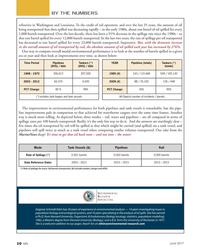 )
June 2017 - Marine News page: 10
)
June 2017 - Marine News page: 10Reference Dates 2003 – 20122010 – 20152010 – 2015 (*) Rate of spillage for every 100 barrels transported. (&) includes tankers, barges and ATB’s. Dagmar Schmidt Etkin has 30 years of experience in environmental analysis — 14 years investigating issues in population biology and ecological systems, and 16 years
-
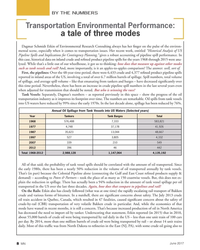 )
June 2017 - Marine News page: 8
)
June 2017 - Marine News page: 8BY THE NUMBERS Transportation Environmental Performance: a tale of three modes Dagmar Schmidt Etkin of Environmental Research Consulting always has her ? nger on the pulse of the environ- mental scene, especially when it comes to transportation issues. Her recent work, entitled “Historical Analysis of US
-
 )
April 2017 - Marine News page: 50
)
April 2017 - Marine News page: 50machinery and cranes deserve equal attention. According systems that Seaspan Marine would convert. Additionally, a to a recent research study by Dagmar Schmidt Etkin, Prin- minimal amount of cleaning and ? ushing of the existing sys- cipal Consultant at Environmental Research Consulting, tems is required
-
 )
October 2016 - Marine News page: 43
)
October 2016 - Marine News page: 43that meetings on this topic. in 2012 vessel traf? c data indicated that 1,961 vessels had passed through Unimak Pass in 4,615 transits, of which Dagmar Schmidt Etkin has 30 years of experience in 45% were engaged in innocent passage. Though they environmental analysis — 14 years investigating issues in
-
 )
October 2016 - Marine News page: 42
)
October 2016 - Marine News page: 42RISK Changing Spill Risk in a Changing Arctic Landscape Industry analyst and environmental consultant Dagmar Schmidt Etkin, PhD, takes a hard look at a rapidly shifting operational landscape in the Arctic. Always an honest broker of information, Etkin tells it like it is. By Dagmar Schmidt Etkin,
-
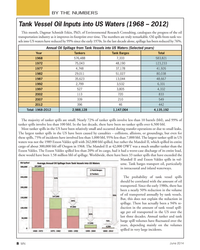 )
June 2014 - Marine News page: 8
)
June 2014 - Marine News page: 8BY THE NUMBERSThis month, Dagmar Schmidt Etkin, PhD, of Environmental Research Consulting, catalogues the progress of the oil transportation industry as it improves its footprint over time. The numbers are truly remarkable. Oil spills from tank ves- sels into US waters have reduced by 99% since the early
-
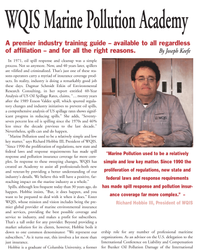 )
April 2012 - Marine News page: 56
)
April 2012 - Marine News page: 56one of these rea- sons operators carry a myriad of insurance coverage prod- ucts. In reality, industry is doing a remarkably good job these days. Dagmar Schmidt Etkin of Environmental Research Consulting, in her report entitled 40-Year Analysis of US Oil Spillage Rates, claims, ? twenty years after the
-
 )
September 2011 - Marine News page: 57
)
September 2011 - Marine News page: 57a host of other Coast Guard initiatives in play, one would think that domestic inland and coastal transport modes leave much to be desired. We asked Dagmar Schmidt Etkin of Environmental Research Consulting to weigh in on the matter. In her report entitled 40-Year Analysis of US Oil Spillage Rates, Etkin claims
-
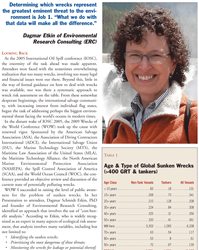 )
August 2011 - Marine News page: 25
)
August 2011 - Marine News page: 25polluting wrecks. WOW I succeeded in raising the level of public aware- ness for the problem of sunken wrecks. In her Presentation to attendees, Dagmar Schmidt Etkin, PhD and founder of Environmental Research Consulting, identified an approach that involves the use of cost-ben- efit analysis.? According
-
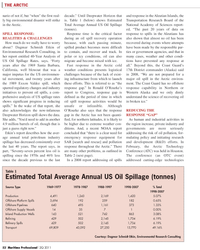 )
Q2 2011 - Maritime Logistics Professional page: 52
)
Q2 2011 - Maritime Logistics Professional page: 52big environmental disaster will strike in the Arctic. SPILL RESPONSE: REALITIES & CHALLENGES How much do we really have to worry about? Dagmar Schmidt Etkin of Environmental Research Consulting, in her report entitled 40-Year Analysis of US Oil Spillage Rates, says, “Forty years after the 1969
-
 )
April 2010 - Marine Technology Reporter page: 43
)
April 2010 - Marine Technology Reporter page: 43have signed an Interagency Agreement to promote coordination on this issue. ASA's panel discussion of the WORP project at OTE will be led by Dr. Dagmar Schmidt Etkin, Panel Chairwoman and President, Environmental Research Consulting. "Twenty years after the Exxon Valdez oiil spill, the threat of oil pollution
-
 )
April 2010 - Marine Technology Reporter page: 41
)
April 2010 - Marine Technology Reporter page: 41M. Merrill, Marine Renewable Energy Council-MREC, University of Massachusetts 1:30 pm ? 3:00 pm Wreck Oil Removal Program (WORP) Speakers include: Dagmar Schmidt Etkin, Ph.D., President, Environmental Research Consulting; Carleen Lyden-Kluss, Executive Director, North Marine Environmental Protection Association
-
 )
September 2009 - Marine Technology Reporter page: 7
)
September 2009 - Marine Technology Reporter page: 7? focused on a number of critical issues surrounding the discovery and mitigation of potential brewing ecological disasters. According to research by Dagmar Schmidt Etkin, PH.D., of Environmental Research Consulting (Cortlandt Manor, NY), there are approximately 8,500 identified large shipwrecks found in the world's
-
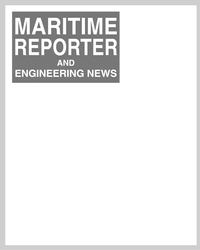 )
April 2010 - Maritime Reporter and Engineering News page: 83
)
April 2010 - Maritime Reporter and Engineering News page: 83M. Merrill, Marine Renewable Energy Council-MREC, University of Massachusetts 1:30 pm ? 3:00 pm ? Wreck Oil Removal Program (WORP) Speakers include: Dagmar Schmidt Etkin, Ph.D., President, Environmental Research Consulting; Carleen Lyden-Kluss, Executive Director, North Marine Environmental Protection Association
-
 )
October 2009 - Maritime Reporter and Engineering News page: 41
)
October 2009 - Maritime Reporter and Engineering News page: 41on a number of critical issues surrounding the discovery and mitigation of potential brewing ecological disasters. According to research by Dagmar Schmidt Etkin, PH.D., of Environmental Research Consulting (Cortlandt Manor, NY), there are approximately 8,500 identified large shipwrecks found in the world's
